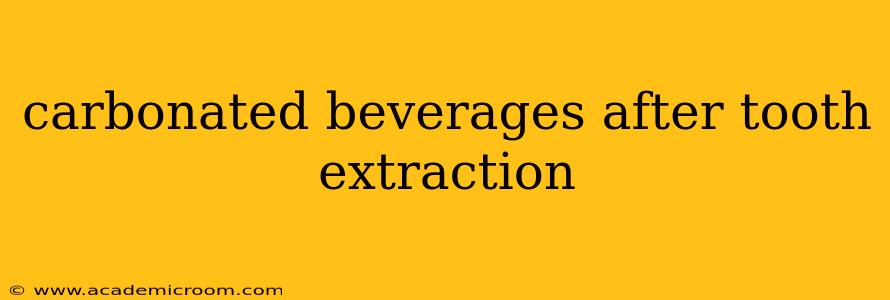Having a tooth extracted can be a somewhat unpleasant experience, and the recovery process requires careful attention to detail. One common question many patients have is about consuming carbonated beverages afterward. The short answer is: it's generally best to avoid carbonated drinks after a tooth extraction. This post will delve into the reasons why and explore some common related questions.
Why Should I Avoid Carbonated Drinks After Tooth Extraction?
Carbonated beverages, whether soda, sparkling water, or even some flavored seltzers, contain carbon dioxide gas. This gas creates pressure within the mouth. This pressure can:
- Dislodge the blood clot: A blood clot forms naturally in the extraction site to promote healing. The pressure from carbon dioxide bubbles can dislodge this clot, leading to a painful condition called dry socket. Dry socket is characterized by intense pain, a bad odor, and a visible empty socket. This necessitates a visit to your dentist for treatment.
- Increase bleeding: The pressure can also disrupt the healing process and potentially increase bleeding at the extraction site, prolonging recovery time.
- Irritate the wound: The acidity of many carbonated drinks, especially sodas, can irritate the sensitive tissues of the extraction site, potentially delaying healing and causing discomfort.
What About Sparkling Water? Isn't that healthier?
While sparkling water lacks the sugar and additives found in many sodas, it still contains carbon dioxide. Therefore, it's best to avoid sparkling water as well after a tooth extraction to minimize the risk of complications. The potential for dislodging the blood clot and causing irritation remains.
Can I Drink Carbonated Beverages After the Initial Healing Period?
It's generally recommended to avoid carbonated beverages for at least 24-48 hours after the extraction, allowing the initial blood clot to properly form. After this period, you can gradually reintroduce them, but it’s wise to start slowly and monitor for any discomfort or increased bleeding. If you experience any issues, stop drinking carbonated beverages and contact your dentist.
What Can I Drink Instead After Tooth Extraction?
Opt for clear liquids that are gentle on the extraction site. Examples include:
- Water (the best choice!)
- Clear broths
- Unsweetened juices (diluted if necessary)
- Herbal teas (cooled)
What are the Signs of a Dry Socket?
Recognizing the signs of a dry socket is crucial for timely treatment. Key indicators include:
- Severe, persistent pain beginning 2-3 days after extraction.
- A bad taste or odor in your mouth.
- Visible empty socket.
If you experience any of these symptoms, contact your dentist immediately.
How Long Does it Take to Fully Recover From a Tooth Extraction?
Full recovery time varies depending on the complexity of the extraction, overall health, and adherence to post-operative instructions. However, most patients see significant improvement within a week or two. Remember to follow your dentist's instructions carefully for optimal healing.
Is it Okay to Use a Straw After Tooth Extraction?
Similar to carbonated drinks, sucking through a straw can create negative pressure that can dislodge the blood clot, leading to a dry socket. It's best to avoid straws for at least the first few days after the procedure.
This information is intended for educational purposes only and does not substitute professional dental advice. Always consult with your dentist or oral surgeon for personalized post-operative instructions following your tooth extraction. They can provide tailored guidance based on your specific situation and ensure a smooth recovery.
